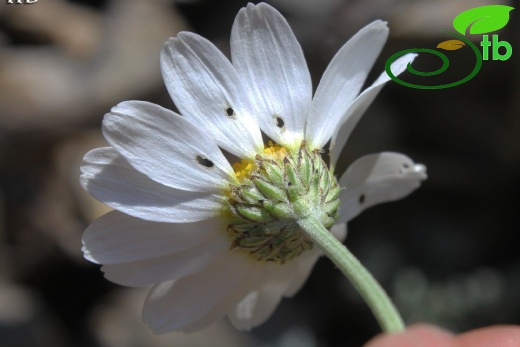Anthemis cretica
Anthemis cretica
Dağ papatyası
Shortly rhizomatous perennial herb, sometimes woody at base, subglabrous or ± densely greyish- or white-pubescent. Stems decumbent, ascending or erect, 10-30 cm, simple or branching. Leaves pinnatisect, up to 5 cm, primary segments usually 3-paired, simple or more often divided into 3-5 oblanceolate ± obtuse secondary segments. Capitula radiate or discoid. Involucre generally 0,75-1,5 cm broad; phyllaries ovate or lanceolate, ± acute, margins ± scarious, colourless, pale or dark brown. Receptacle often becoming somewhat conical at maturity; paleae lanceolate, carinate. Ray flowers when present white, usually fertile; ligules elliptic, 0,5-1,25 cm. Disc flowers yellow, corolla-tube usually becoming inflated at maturity. Achenes obpyramidal, ± squarish in section, 1,5-3,5 mm, smooth, sulcate or especially the outer subtuberculate. Pappus auriculate or coroniform, ± absent or up to 1 mm, scarious.
This is a highly polymorphic species in which a number of different taxa are recognizable and have been variously treated at specific or infraspecific levels by previous authors. The following is a tentative classification but, such is the degree of intergradation, no satisfactory scheme seems possible without some biosystematic study; numerous intermediates occur between the subspecies recognized here; radiate and. discoid variants are treated informally and epithets have not been given to them as it has seemed difficult to avoid confusion with those applied, perhaps slightly differently, in Europe. The external distribution has been curtailed due to lack of information. The illegitimacy of the name A. montana L. is discussed by Grierson in Notes R.B.G. Edinb. 33: 212 .
1. Leaf segments linear-lanceolate, c. 0,5 mm broad, acute or acuminate ; radiate and discoid plants .....................e. subsp. leucanthemoides
1. Leaf segments oblanceolate or obovate, usually more than 0,5 mm broad, obtuse or subacute .
2. Lower or median leaves usually more than 2 cm
3. Phyllaries with dark brown or blackish margins; plants radiate and discoid, or radiate only .
4. Taller plants 30-40 cm tall; radiate and discoid plants
5. Leaf segments 1,5 mm or less broad ............................... b..subsp. albida
5. Leaf segments 2-3,5 mm broad ...................................g. subsp. cassia
4. Smaller plants 15 cm tall ; radiate plants only
6. Leaves usually glabrous
6. Leaves ± densely whitish pubescent .........k. subsp. iberica
3. Phyllaries with whitish or pale brown ma.rgins; plants radiate· and discoid
7. Primary leaf segments divided into 7 or more segments .................h. subsp. absinthifolia
7. Primary leaf segments divided into 3 or 5 segments
8. Stems elongate, 30-45 cm, much branched . .........................i.subsp. candicans
8. Stems 10-20 cm, simple or branched only near base
9. Plants usually with several leafy sterile shoots; leaf segments ± contiguous ................a. subsp. pontica
9. Plants without or with few sterile shoots; leaf segments ± distant ..............f. subsp. umbilicata
2. Lower and median leaves usually less than 2 cm
10. Phyllaries with whitish or pale brown margins; radiate or discoid plants
11. Indumentum dense, leaves often greyish or white; marginal achenes usually subtuberculate .......d. subsp. anatolica
11. Indumentum ± sparse, leaves green; marginal achenes smooth c. subsp. tenuiloba
10. Phyllaries with dark brown or blackish margins; radiate plants only l. subsp. argaea













